Legacy is such a great format. There’s this one deck; it makes your opponents cast spells. Then somehow you win.
Wait, what? Opponents have to cast spells? This isn’t some Phelddagrif group-hug EDH deck we’re talking about. This is a deck that top 8ed both Grand Prix Amsterdam and Grand Prix Providence!
Creatures (3)
Lands (19)
Spells (38)
- 4 Brainstorm
- 4 Show and Tell
- 3 Grim Monolith
- 4 Force of Will
- 4 Intuition
- 1 Misdirection
- 4 Pact of Negation
- 4 Pact of the Titan
- 1 Slaughter Pact
- 1 Summoner's Pact
- 4 Ponder
- 4 Hive Mind
Sideboard

Hive Mind: the deck has two main combos spliced into the same deck.
Show and Tell + Emrakul, the Aeons Torn
Show and Tell into Emrakul, the Aeons Torn puts a very large threat onto the battlefield as early as turn two, and most decks only have a small handful of ways to deal with it.
Hive Mind + Pact of the Titan (or any other Pact)
The Hive Mind combo works by forcing an opponent to cast one or more Pacts and leave them unable to pay the associated upkeep costs.
The Hive Mind combo is the cheapest two-card combo legal in Legacy, matching Painter’s Servant + Grindstone on sheer mana cost. This cheap cost comes at a price, as Hive Mind won’t always kill if the combo is assembled. A clever opponent can just tap some lands!
The rest of the deck is centered around these two combos. Intuition provides additional copies of any combo piece. Pact of Negation can protect either combo, depending on how much mana is available. Grim Monolith and Show and Tell both put Hive Mind into play sooner.
How does Hive Mind win? Thanks to Eli Kassis, I was able to borrow some virtual cards and create an illustrated guide of comboing out with Hive Mind.
It is the Hive Mind player’s turn. They have just resolved a Hive Mind.
Step 1: Cast a Pact. In this case, we’re using Summoner’s Pact, but Pact of the Titan is functionally identical. Note, the Hive Mind trigger goes on the stack immediately following the action of casting Summoner’s Pact.
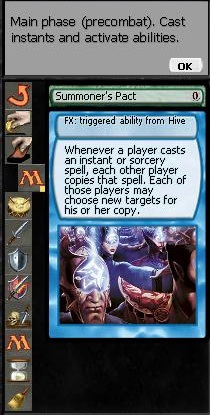
Step 2: Sometimes, our opponent will be able to pay for a single Pact or can otherwise interact with us. Here, we’re responding to the Hive Mind trigger with a Pact of Negation, targeting our Summoner’s Pact.
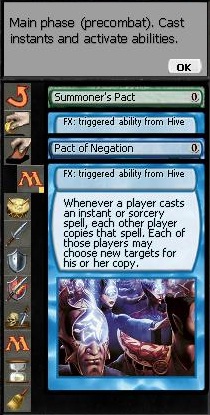
Step 3: We let the Hive Mind trigger resolve. (Picture is from the point of view of the opponent, in the middle of the resolution of the Hive Mind trigger.) Our opponent can choose what his Pact of Negation copy will target. Note the choices are either our Summoner’s Pact or our Pact of Negation. Our opponent decides to counter our Summoner’s Pact. (Aside: It is usually better to counter the Pact of Negation, as Hive Mind has no way to pay for Summoner’s Pact if they get another turn.
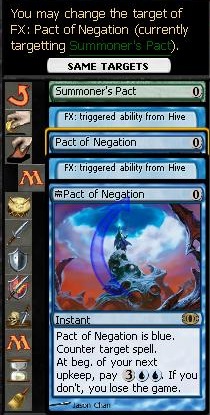
Step 4: Our copy of Pact of Negation is still on the stack. It will resolve and be countered on resolution due to an illegal target. Since our opponent was kind enough to counter our copy of Summoner’s Pact, we will have no upkeep liabilities. They are not nearly as fortunate.
(Rules Tip: CR 701.5a “To counter a spell or ability means to cancel it, removing it from the stack.” Once a spell is countered, it is removed from the stack. This can potentially be relevant in some cases)
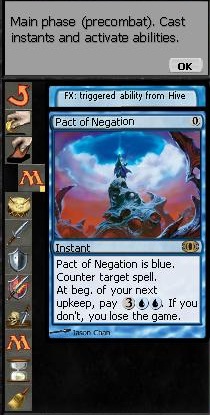
Step 5: Our Pact of Negation is countered by the game’s rules. Hive Mind’s trigger is put on the stack and will resolve, creating a Summoner’s Pact copy for our opponent.
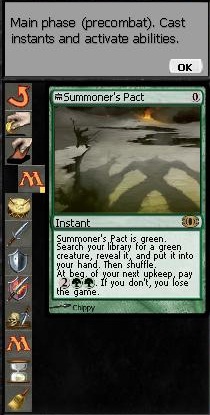
Step 6: Pass the turn and profit. Our opponent must pay both 3UU and 2GG to stay in the game.
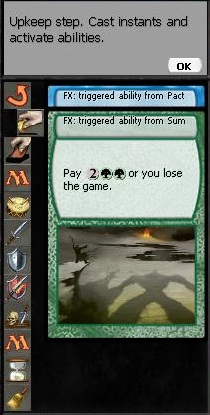
This seems like a great deck… just cast a Hive Mind, then a couple free spells and win… what could possibly go wrong?
Oh. Evidently a lot can go wrong. It’s a good thing nobody plays those cards, right?
Hive Mind is not well positioned against the metagame at large. It has issues winning against any decks containing several of the above cards… so every blue deck, more or less.
Yes, this is a very substantial change in positioning from earlier this summer. Hive Mind was relatively unaffected by Mental Misstep, while many of the decks it feared—those with Daze and Stifle—faded out of the metagame. In that era, the blue decks were slow, grinding decks that won by playing Squires and Sword of Feast and Famine, holding up Counterspells and Force of Wills.
Hive Mind enjoyed success against these types of decks because they had access to more must-answer threats. Show and Tell and Hive Mind needed to be countered, while Hive Mind has Force of Will and Pact of Negation to protect itself. In short, Hive Mind had more relevant interactive spells than the control decks, allowing them to create a board state where they could force through a key spell.
Although there are many tools that can beat Hive Mind, these tools need to be played correctly to be effective.
Stifle
In this matchup, Stifle should only rarely be used on their fetchlands, such as when you feel that they kept a hand with only a single colored source or your hand contains multiple disruptive elements. Hive Mind has a full eight cantrips to find additional lands, and holding up mana for Stifle makes it more difficult for you to put a clock on them in any way.
Stifle has three real targets in the late game. It can counter the Emrakul, the Aeons Torn annihilator trigger, if you already have lethal damage on board for the counter-swing. Once Hive Mind is on the battlefield, Stifle can counter two triggers: Hive Mind’s “copy that spell” trigger and the “pay for this spell in my upkeep” trigger. Countering either of these can be correct, and it depends largely on how much mana both players have.
Let’s look at the earlier example I posted, where I walked through how Hive Mind combos out. As a quick summary, our opponent has cast Summoner’s Pact and Pact of Negation (we’re now playing against the Hive Mind deck). This example is grossly simplified to focus on what matters. Here’s the board state:
Our opponent:
Us:
We have only the Volcanic Island untapped, while our opponent has tapped out. Here, the play is to just Stifle the copy of Pact of Negation, as we won’t be able to pay for it on our upkeep.
When would we want to counter the trigger on our turn?
Let’s take the exact same board state… except our opponent cast Show and Tell, putting their Hive Mind into play, and cast only Pact of the Titan and no additional Pacts. We tapped two mana on our turn to play Tarmogoyf.
Our opponent has an untapped Ancient Tomb and Island. We have two untapped Volcanic Island. There is a Pact of the Titan spell on the stack and a Hive Mind trigger for the Pact of the Titan on the stack.
Do we Stifle our upkeep trigger or the copy trigger?
I’ve already presented the situation that we want to counter on our turn, but what is the reason?
Let’s assume we cast Stifle on their turn. Hive Mind will trigger on the Stifle, creating a copy. The Hive Mind player has two options for their Stifle: either the Pact of the Titan copy ability or the Hive Mind trigger produced from casting Stifle. Since the copy of Stifle is being put on the stack during the resolution of Hive Mind’s triggered ability, Hive Mind’s triggered ability is a legal target for the copy of Stifle.
The Stack:
Hive Mind (Pact of the Titan)
Stifle (targeting Hive Mind (Pact of the Titan)
Stifle (targeting Hive Mind (Stifle))
Now our opponent plays Flusterstorm. The storm count is three at this point. With four copies targeting Stifle, Stifle will be countered regardless of what we do.
Let’s rewind the situation. If we wait until our turn to Stifle our Pact’s upkeep trigger, their Flusterstorm forces us to pay an additional mana for our Stifle, but it is a mana we can easily afford.
Daze
Daze is one of the few ways to win after Hive Mind is on the battlefield. Daze can counter your copy of a Pact like this:
Pact of the Titan (opponent)
Pact of the Titan (yours)
Daze (yours, targeting Pact of the Titan (yours))
Daze (opponent, targeting Daze)
You can choose to pay one for your Daze to resolve and then choose not to pay one to counter your own Pact of the Titan. This is limited by the amount of free mana you have available, as you still need to pay one for each Pact. Your opponent essentially needs more Pacts than you have Dazes or mana available to win.
One of the real challenges of playing against Hive Mind is figuring out how they’re going to beat you. A bare Show and Tell may reveal a Hive Mind, or they may Eldrazi you with Emrakul, the Aeons Torn. Both of these plans require a different application of resources. Casting Daze on the Show and Tell will halt the Eldrazi menace, while holding Daze for their Hive Mind could result in an easy win.
Generally, casting Daze on the Show and Tell will be the right move, as there is no guarantee that our opponent only has a single Pact.
Flusterstorm
Flusterstorm is like a Super-Daze. Theoretically, it can counter every Pact on the stack. In practice, Flusterstorm will only be able to counter an early Show and Tell, or serve as a Stifle, stopping one of our Pacts only. Hive Mind players typically will play their Pacts so each one will resolve individually. Going back to the introduction, if the non-Hive Mind player had Flusterstorm, they would only be able to counter Summoner’s Pact or Pact of Negation, but not both.
Spellstutter Sprite / Venser, Shaper Savant
Both of these creatures have abilities that can target our copies of Pacts. Since Hive Mind won’t copy the creatures, these are both good ways to counter single Pact copies.
Angel’s Grace, etc.
The second group of spells grants the ability to either skip your upkeep step or not lose to the triggered abilities of the Pacts. Most of these are narrow and only playable in very narrow situations.
Ethersworn Canonist is surprisingly strong against Hive Mind. Ethersworn Canonist limits the Hive Mind player to a single Pact per turn, which makes it easier to pay for them on your turn. Also, it shuts off Pact of Negation as a live card after a Hive Mind, one of the hardest Pacts to pay for.
The last card that merits discussion is Word of Command. This Alpha through Unlimited rare can force a Hive Mind player to cast their own Pacts at a very inconvenient time. I don’t really think it’s a particularly good card, as it is pricy and narrow, but if your local meta is filled with Hive Mind, you’re allergic to Force of Will, and you have some of these floating around, it is an option.
Playing Hive Mind in the real world
Despite my best efforts to communicate game states throughout this article, I am sure at some points, you, the reader, have been confused. For that, I apologize. Hopefully, you understand just how bewildering game states can become with Hive Mind on the battlefield.
Communication is incredibly important if you are playing Hive Mind or playing against it. Once Hive Mind is on the battlefield, both players need to make it their primary mission to communicate with each other exactly where the game state is.
If you have several interactive cards after a Hive Mind has resolved, it is in your best interest to call a judge and have a third set of eyes on the match, simply because small choices, like resolving a trigger or leaving it on the stack or even maintaining priority or passing priority can drastically modify the result of a game.
I’m not advocating calling a judge every time an opponent plays Hive Mind, but if you look down at a Stifle and Flusterstorm, proper communication can be the difference between a win and a loss.
In many cases, both as a player and judge, I will write down what is on the stack and communicate it thoroughly with all players involved. Hive Mind is one of the things that Magic Online works better for, which is why I included screenshots from there in the introduction.
A way of representing this in real life is to lay out the stack across the table, as both you and your opponents cast spells, while using tokens to represent copies of spells. This can be seen from Ben Swartz in the finals of Star City Seattle. (5:50)
A Real Tournament
I ran the deck through four rounds of competition at my local store. Yes, I know Hive Mind is not the best deck in the format, or even close. That doesn’t mean I shouldn’t be playing tier 2 or tier 3 decks. It’s a $5 local event. My goal is to play as many different decks as I can at my local tournaments, since piloting a deck makes it easier to understand how to play against it.
I played against Elves, Goblins, Team Italia, and Zoo.
The aggro matchups were completely trivial. Their only hope is to try and race, and I had enough disruption to stop them from doing that. There was one interesting hand…
It was game two, on the draw against Goblins. Do we go for it?
I kept the hand, hoping that he did not have a way to interact with my manabase. First draw step… brick. He cast a Warren Instigator, which was Forced. Second draw step, brick. He played a Goblin Chieftain, which connected. Third draw step, brick. He cast a Goblin Ringleader, which got countered as well. Fourth draw step, Island. I’ll Show and Tell you all about my win.
Team Italia was a battle, back and forth. His deck had a large amount of disruption, including a maindeck way to deal with Emrakul, the Aeons Torn (Grim Lavamancer + Basilisk Collar). One of the interesting interactions that came up was his Hymn to Tourach. I Brainstormed in response… but had an Emrakul, the Aeons Torn in my hand. If his Hymn to Tourach hit my Emrakul, the Aeons Torn, I would be forced to shuffle away any cards I hid with Brainstorm; hardly the ideal situation!
Team Italia also had Ethersworn Canonist, a card that was hard to combo through. In our game, he had five lands in play, including a red and black source. My only out to kill him was to play Summoner’s Pact or to cast Grim Monolith and Pact of Negation my own Grim Monolith. Neither of these was a particularly good plan.
I hope this article and my article on Aluren were helpful in understanding Legacy. Since I want to play a variety of different decks in the future, please sound off in the comments on what decks you want to see me focus on next!
mchain on Magic Online
@mchainmail on Twitter

